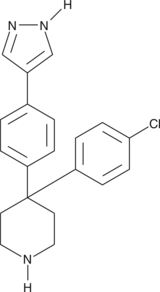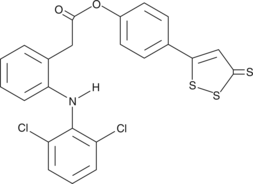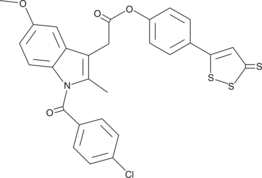Chemicals
Showing 10201–10350 of 41137 results
-
Asunaprevir is an inhibitor of the hepatitis C non-structural 3/4A serine protease, which is required for viral replication.{32953} It is a direct-acting inhibitor of hepatitis C virus (HCV).{32953,32952} It is commonly used in combination with daclatasvir and beclabuvir, which are also direct-acting HCV inhibitors.{32953}
Brand:CaymanSKU:20835 -Out of stock
Asunaprevir is an inhibitor of the hepatitis C non-structural 3/4A serine protease, which is required for viral replication.{32953} It is a direct-acting inhibitor of hepatitis C virus (HCV).{32953,32952} It is commonly used in combination with daclatasvir and beclabuvir, which are also direct-acting HCV inhibitors.{32953}
Brand:CaymanSKU:20835 -Out of stock
Asunaprevir is an inhibitor of the hepatitis C non-structural 3/4A serine protease, which is required for viral replication.{32953} It is a direct-acting inhibitor of hepatitis C virus (HCV).{32953,32952} It is commonly used in combination with daclatasvir and beclabuvir, which are also direct-acting HCV inhibitors.{32953}
Brand:CaymanSKU:20835 -Out of stock
Aszonalenin is a hexahydropyrrolo[2,3-b]indole-containing fungal metabolite produced by A. zonatus and N. tatenoi.{41719,41720}
Brand:CaymanSKU:25018 - 1 mgAvailable on backorder
Aszonalenin is a hexahydropyrrolo[2,3-b]indole-containing fungal metabolite produced by A. zonatus and N. tatenoi.{41719,41720}
Brand:CaymanSKU:25018 - 5 mgAvailable on backorder
Aszonapyrone A is a meroditerpene fungal metabolite that has been found in Neosartorya and has diverse biological activities.{41303,41304,41720} It inhibits the growth of MCF-7, NCI H460, and A375-C5 cancer cells (GI50s = 13.6, 11.6, and 10.2 μM, respectively).{41303} Aszonapyrone A is active against multidrug-resistant isolates of S. aureus, E. faecalis, and E. faecium (MICs = 8, 16, and 16 μg/ml, respectively) and inhibits S. aureus biofilm formation.{41304} It is also active against P. falciparum in vitro (IC50 = 1.34 μg/ml).{41720}
Brand:CaymanSKU:29940 - 2.5 mgAvailable on backorder
Aszonapyrone A is a meroditerpene fungal metabolite that has been found in Neosartorya and has diverse biological activities.{41303,41304,41720} It inhibits the growth of MCF-7, NCI H460, and A375-C5 cancer cells (GI50s = 13.6, 11.6, and 10.2 μM, respectively).{41303} Aszonapyrone A is active against multidrug-resistant isolates of S. aureus, E. faecalis, and E. faecium (MICs = 8, 16, and 16 μg/ml, respectively) and inhibits S. aureus biofilm formation.{41304} It is also active against P. falciparum in vitro (IC50 = 1.34 μg/ml).{41720}
Brand:CaymanSKU:29940 - 500 µgAvailable on backorder
AT-121 is a dual μ-opioid and nociceptin receptor partial agonist (Kis = 16.49 and 3.67 nM, respectively).{35507} It stimulates [35S]GTPγS binding to cell membranes expressing μ-opioid or nociceptin receptors (EC50s = 19.6 and 34.7 nM, respectively). AT-121 (0.003-0.03 mg/kg) decreases capsaicin-induced thermal allodynia without increasing scratching activity in rhesus monkeys in a dose-dependent manner. It lacks reinforcing effects, a marker of abuse potential, and reduces oxycodone, but not food pellet, reinforcement in a drug self-administration assay in rhesus monkeys when administered at doses ranging from 0.3 to 10 μg/kg per injection. AT-121 (0.01 or 0.03 mg/kg) does not induce hyperalgesia, a marker of tolerance development, in rhesus monkeys.
Brand:CaymanSKU:26150 - 1 mgAvailable on backorder
AT-121 is a dual μ-opioid and nociceptin receptor partial agonist (Kis = 16.49 and 3.67 nM, respectively).{35507} It stimulates [35S]GTPγS binding to cell membranes expressing μ-opioid or nociceptin receptors (EC50s = 19.6 and 34.7 nM, respectively). AT-121 (0.003-0.03 mg/kg) decreases capsaicin-induced thermal allodynia without increasing scratching activity in rhesus monkeys in a dose-dependent manner. It lacks reinforcing effects, a marker of abuse potential, and reduces oxycodone, but not food pellet, reinforcement in a drug self-administration assay in rhesus monkeys when administered at doses ranging from 0.3 to 10 μg/kg per injection. AT-121 (0.01 or 0.03 mg/kg) does not induce hyperalgesia, a marker of tolerance development, in rhesus monkeys.
Brand:CaymanSKU:26150 - 100 µgAvailable on backorder
AT-121 is a dual μ-opioid and nociceptin receptor partial agonist (Kis = 16.49 and 3.67 nM, respectively).{35507} It stimulates [35S]GTPγS binding to cell membranes expressing μ-opioid or nociceptin receptors (EC50s = 19.6 and 34.7 nM, respectively). AT-121 (0.003-0.03 mg/kg) decreases capsaicin-induced thermal allodynia without increasing scratching activity in rhesus monkeys in a dose-dependent manner. It lacks reinforcing effects, a marker of abuse potential, and reduces oxycodone, but not food pellet, reinforcement in a drug self-administration assay in rhesus monkeys when administered at doses ranging from 0.3 to 10 μg/kg per injection. AT-121 (0.01 or 0.03 mg/kg) does not induce hyperalgesia, a marker of tolerance development, in rhesus monkeys.
Brand:CaymanSKU:26150 - 500 µgAvailable on backorder
AT-13148 is an orally bioavailable and ATP-competitive multi-AGC kinase inhibitor.{38275} It inhibits Akt1, 2, and 3 (IC50s = 38, 402, and 50 nM, respectively), in addition to other AGC kinase family members p70S6K, PKA, ROCK-I, and ROCK-II (IC50s = 3-8 nM). AT-13148 inhibits growth of cancer cell lines with genetic mutations in PI3K-Akt-mTOR and RAS-RAF signaling pathways (GI50s = 1.54-3.77 μM). In vivo administration of AT-13148 (50 mg/kg, p.o.) inhibits the growth of MES-SA uterine sarcoma and BT474 breast cancer xenografts in mice by inhibiting Akt and p70S6K kinases. AT-13148 also stably inhibits ROCK-dependent phosphorylation of myosin light chain (MLC2) over a 24-hour period in 4599 mouse melanoma cells (EC50 = 0.1 μM).{38276} Oral administration at a dose of 40 mg/kg reduces motility of 4699 melanoma cells in murine xenograft model.
Brand:CaymanSKU:21597 -Out of stock
AT-13148 is an orally bioavailable and ATP-competitive multi-AGC kinase inhibitor.{38275} It inhibits Akt1, 2, and 3 (IC50s = 38, 402, and 50 nM, respectively), in addition to other AGC kinase family members p70S6K, PKA, ROCK-I, and ROCK-II (IC50s = 3-8 nM). AT-13148 inhibits growth of cancer cell lines with genetic mutations in PI3K-Akt-mTOR and RAS-RAF signaling pathways (GI50s = 1.54-3.77 μM). In vivo administration of AT-13148 (50 mg/kg, p.o.) inhibits the growth of MES-SA uterine sarcoma and BT474 breast cancer xenografts in mice by inhibiting Akt and p70S6K kinases. AT-13148 also stably inhibits ROCK-dependent phosphorylation of myosin light chain (MLC2) over a 24-hour period in 4599 mouse melanoma cells (EC50 = 0.1 μM).{38276} Oral administration at a dose of 40 mg/kg reduces motility of 4699 melanoma cells in murine xenograft model.
Brand:CaymanSKU:21597 -Out of stock
AT-13148 is an orally bioavailable and ATP-competitive multi-AGC kinase inhibitor.{38275} It inhibits Akt1, 2, and 3 (IC50s = 38, 402, and 50 nM, respectively), in addition to other AGC kinase family members p70S6K, PKA, ROCK-I, and ROCK-II (IC50s = 3-8 nM). AT-13148 inhibits growth of cancer cell lines with genetic mutations in PI3K-Akt-mTOR and RAS-RAF signaling pathways (GI50s = 1.54-3.77 μM). In vivo administration of AT-13148 (50 mg/kg, p.o.) inhibits the growth of MES-SA uterine sarcoma and BT474 breast cancer xenografts in mice by inhibiting Akt and p70S6K kinases. AT-13148 also stably inhibits ROCK-dependent phosphorylation of myosin light chain (MLC2) over a 24-hour period in 4599 mouse melanoma cells (EC50 = 0.1 μM).{38276} Oral administration at a dose of 40 mg/kg reduces motility of 4699 melanoma cells in murine xenograft model.
Brand:CaymanSKU:21597 -Out of stock
AT-13148 is an orally bioavailable and ATP-competitive multi-AGC kinase inhibitor.{38275} It inhibits Akt1, 2, and 3 (IC50s = 38, 402, and 50 nM, respectively), in addition to other AGC kinase family members p70S6K, PKA, ROCK-I, and ROCK-II (IC50s = 3-8 nM). AT-13148 inhibits growth of cancer cell lines with genetic mutations in PI3K-Akt-mTOR and RAS-RAF signaling pathways (GI50s = 1.54-3.77 μM). In vivo administration of AT-13148 (50 mg/kg, p.o.) inhibits the growth of MES-SA uterine sarcoma and BT474 breast cancer xenografts in mice by inhibiting Akt and p70S6K kinases. AT-13148 also stably inhibits ROCK-dependent phosphorylation of myosin light chain (MLC2) over a 24-hour period in 4599 mouse melanoma cells (EC50 = 0.1 μM).{38276} Oral administration at a dose of 40 mg/kg reduces motility of 4699 melanoma cells in murine xenograft model.
Brand:CaymanSKU:21597 -Out of stock
AT-406 is an orally bioavailable Smac/DIABLO mimetic and antagonist of the inhibitor of apoptosis proteins (IAPs). It binds to XIAP, cIAP1, and cIAP2 proteins with Ki values of 66.4, 1.9, and 5.1 nM, respectively.{31969} It has been shown to inhibit cancer cell growth in various human cancer cell lines and to induce apoptosis in xenograft tumors in mice.{31969,31968}
Brand:CaymanSKU:19929 -Available on backorder
AT-406 is an orally bioavailable Smac/DIABLO mimetic and antagonist of the inhibitor of apoptosis proteins (IAPs). It binds to XIAP, cIAP1, and cIAP2 proteins with Ki values of 66.4, 1.9, and 5.1 nM, respectively.{31969} It has been shown to inhibit cancer cell growth in various human cancer cell lines and to induce apoptosis in xenograft tumors in mice.{31969,31968}
Brand:CaymanSKU:19929 -Available on backorder
AT-406 is an orally bioavailable Smac/DIABLO mimetic and antagonist of the inhibitor of apoptosis proteins (IAPs). It binds to XIAP, cIAP1, and cIAP2 proteins with Ki values of 66.4, 1.9, and 5.1 nM, respectively.{31969} It has been shown to inhibit cancer cell growth in various human cancer cell lines and to induce apoptosis in xenograft tumors in mice.{31969,31968}
Brand:CaymanSKU:19929 -Available on backorder
AT-406 is an orally bioavailable Smac/DIABLO mimetic and antagonist of the inhibitor of apoptosis proteins (IAPs). It binds to XIAP, cIAP1, and cIAP2 proteins with Ki values of 66.4, 1.9, and 5.1 nM, respectively.{31969} It has been shown to inhibit cancer cell growth in various human cancer cell lines and to induce apoptosis in xenograft tumors in mice.{31969,31968}
Brand:CaymanSKU:19929 -Available on backorder
Prostaglandin D synthase (PGDS) catalyzes the isomerization of PGH2 to produce PGD2. PGD2 induces sleep, regulates nociception, inhibits platelet aggregation, and acts as an allergic mediator. Two distinct types of PGDS have been identified, namely the lipocalin-type enzyme (β-trace, L-PGDS) and the hematopoietic-type enzyme (H-PGDS).{8448,9588,12044} L-PGDS is localized in the central nervous system, male genital organs of various mammals, and the human heart and is a major protein in human cerebrospinal fluid (CSF).{8448} AT-56 is a selective, competitive, and highly bioavailable inhibitor of lipocalin-type prostaglandin D synthase (L-PGDS) with a Ki value of 75 µM.{16647} It inhibits the production of PGD2 by L-PGDS-expressing cells purified from human CSF and recombinant mouse cells with an IC50 value of 95 µM.{16647} At concentrations as high as 100 µM in vitro or 30 mg/kg in vivo, AT-56 does not affect the production of PGE2, PGF2α, or H-PGDS-catalyzed PGD2.{16647} At 10 mg/kg AT-56, the numbers of total cells, infiltrating eosinophils, and monocytes in bronchoalveolar lavage fluid of L-PGDS transgenic mice were decreased to 23, 6, and 41% of controls, respectively.{16647}
Brand:CaymanSKU:-Prostaglandin D synthase (PGDS) catalyzes the isomerization of PGH2 to produce PGD2. PGD2 induces sleep, regulates nociception, inhibits platelet aggregation, and acts as an allergic mediator. Two distinct types of PGDS have been identified, namely the lipocalin-type enzyme (β-trace, L-PGDS) and the hematopoietic-type enzyme (H-PGDS).{8448,9588,12044} L-PGDS is localized in the central nervous system, male genital organs of various mammals, and the human heart and is a major protein in human cerebrospinal fluid (CSF).{8448} AT-56 is a selective, competitive, and highly bioavailable inhibitor of lipocalin-type prostaglandin D synthase (L-PGDS) with a Ki value of 75 µM.{16647} It inhibits the production of PGD2 by L-PGDS-expressing cells purified from human CSF and recombinant mouse cells with an IC50 value of 95 µM.{16647} At concentrations as high as 100 µM in vitro or 30 mg/kg in vivo, AT-56 does not affect the production of PGE2, PGF2α, or H-PGDS-catalyzed PGD2.{16647} At 10 mg/kg AT-56, the numbers of total cells, infiltrating eosinophils, and monocytes in bronchoalveolar lavage fluid of L-PGDS transgenic mice were decreased to 23, 6, and 41% of controls, respectively.{16647}
Brand:CaymanSKU:-Prostaglandin D synthase (PGDS) catalyzes the isomerization of PGH2 to produce PGD2. PGD2 induces sleep, regulates nociception, inhibits platelet aggregation, and acts as an allergic mediator. Two distinct types of PGDS have been identified, namely the lipocalin-type enzyme (β-trace, L-PGDS) and the hematopoietic-type enzyme (H-PGDS).{8448,9588,12044} L-PGDS is localized in the central nervous system, male genital organs of various mammals, and the human heart and is a major protein in human cerebrospinal fluid (CSF).{8448} AT-56 is a selective, competitive, and highly bioavailable inhibitor of lipocalin-type prostaglandin D synthase (L-PGDS) with a Ki value of 75 µM.{16647} It inhibits the production of PGD2 by L-PGDS-expressing cells purified from human CSF and recombinant mouse cells with an IC50 value of 95 µM.{16647} At concentrations as high as 100 µM in vitro or 30 mg/kg in vivo, AT-56 does not affect the production of PGE2, PGF2α, or H-PGDS-catalyzed PGD2.{16647} At 10 mg/kg AT-56, the numbers of total cells, infiltrating eosinophils, and monocytes in bronchoalveolar lavage fluid of L-PGDS transgenic mice were decreased to 23, 6, and 41% of controls, respectively.{16647}
Brand:CaymanSKU:-Prostaglandin D synthase (PGDS) catalyzes the isomerization of PGH2 to produce PGD2. PGD2 induces sleep, regulates nociception, inhibits platelet aggregation, and acts as an allergic mediator. Two distinct types of PGDS have been identified, namely the lipocalin-type enzyme (β-trace, L-PGDS) and the hematopoietic-type enzyme (H-PGDS).{8448,9588,12044} L-PGDS is localized in the central nervous system, male genital organs of various mammals, and the human heart and is a major protein in human cerebrospinal fluid (CSF).{8448} AT-56 is a selective, competitive, and highly bioavailable inhibitor of lipocalin-type prostaglandin D synthase (L-PGDS) with a Ki value of 75 µM.{16647} It inhibits the production of PGD2 by L-PGDS-expressing cells purified from human CSF and recombinant mouse cells with an IC50 value of 95 µM.{16647} At concentrations as high as 100 µM in vitro or 30 mg/kg in vivo, AT-56 does not affect the production of PGE2, PGF2α, or H-PGDS-catalyzed PGD2.{16647} At 10 mg/kg AT-56, the numbers of total cells, infiltrating eosinophils, and monocytes in bronchoalveolar lavage fluid of L-PGDS transgenic mice were decreased to 23, 6, and 41% of controls, respectively.{16647}
Brand:CaymanSKU:-AT-9283 is a broad spectrum kinase inhibitor that potently inhibits Aurora A, Aurora B, JAK2, JAK3, and c-ABL (IC50s = 3, 3, 1.2, 1.1, and 4 nM, respectively).{24830} It also potently (IC50 = receptor tyrosine kinases.{24830} As Aurora kinases have roles in mitosis, inhibitors of these kinases, including AT-9283, have potential in cancer therapy.{24832} Consistent with this, AT-9283 is effective in preventing proliferation of cancer cells both in vitro and in vivo and this effect may be enhanced by combination therapy with other chemotherapeutics.{24831,24829}
Brand:CaymanSKU:11496 - 10 mgAvailable on backorder
AT-9283 is a broad spectrum kinase inhibitor that potently inhibits Aurora A, Aurora B, JAK2, JAK3, and c-ABL (IC50s = 3, 3, 1.2, 1.1, and 4 nM, respectively).{24830} It also potently (IC50 = receptor tyrosine kinases.{24830} As Aurora kinases have roles in mitosis, inhibitors of these kinases, including AT-9283, have potential in cancer therapy.{24832} Consistent with this, AT-9283 is effective in preventing proliferation of cancer cells both in vitro and in vivo and this effect may be enhanced by combination therapy with other chemotherapeutics.{24831,24829}
Brand:CaymanSKU:11496 - 25 mgAvailable on backorder
AT-9283 is a broad spectrum kinase inhibitor that potently inhibits Aurora A, Aurora B, JAK2, JAK3, and c-ABL (IC50s = 3, 3, 1.2, 1.1, and 4 nM, respectively).{24830} It also potently (IC50 = receptor tyrosine kinases.{24830} As Aurora kinases have roles in mitosis, inhibitors of these kinases, including AT-9283, have potential in cancer therapy.{24832} Consistent with this, AT-9283 is effective in preventing proliferation of cancer cells both in vitro and in vivo and this effect may be enhanced by combination therapy with other chemotherapeutics.{24831,24829}
Brand:CaymanSKU:11496 - 5 mgAvailable on backorder
AT-9283 is a broad spectrum kinase inhibitor that potently inhibits Aurora A, Aurora B, JAK2, JAK3, and c-ABL (IC50s = 3, 3, 1.2, 1.1, and 4 nM, respectively).{24830} It also potently (IC50 = receptor tyrosine kinases.{24830} As Aurora kinases have roles in mitosis, inhibitors of these kinases, including AT-9283, have potential in cancer therapy.{24832} Consistent with this, AT-9283 is effective in preventing proliferation of cancer cells both in vitro and in vivo and this effect may be enhanced by combination therapy with other chemotherapeutics.{24831,24829}
Brand:CaymanSKU:11496 - 50 mgAvailable on backorder
AT7519 is an ATP-competitive inhibitor of cyclin-dependent kinases (Cdks) with IC50 values of 210, 47, 100, 13, 170, and 50 = 89 nM).{30113} AT7519 demonstrates antiproliferative activity against a wide variety of human tumor cell lines (IC50s = 40-940 nM in vitro), inhibiting cell cycle progression and inducing apoptosis, and prevents tumor growth in human tumor xenograft models.{30113,30112} AT7519 induces activation of GSK3β by down-regulating GSK3β phosphorylation, which contributes to AT7519-induced apoptosis.{30112}
Brand:CaymanSKU:-AT7519 is an ATP-competitive inhibitor of cyclin-dependent kinases (Cdks) with IC50 values of 210, 47, 100, 13, 170, and 50 = 89 nM).{30113} AT7519 demonstrates antiproliferative activity against a wide variety of human tumor cell lines (IC50s = 40-940 nM in vitro), inhibiting cell cycle progression and inducing apoptosis, and prevents tumor growth in human tumor xenograft models.{30113,30112} AT7519 induces activation of GSK3β by down-regulating GSK3β phosphorylation, which contributes to AT7519-induced apoptosis.{30112}
Brand:CaymanSKU:-AT7519 is an ATP-competitive inhibitor of cyclin-dependent kinases (Cdks) with IC50 values of 210, 47, 100, 13, 170, and 50 = 89 nM).{30113} AT7519 demonstrates antiproliferative activity against a wide variety of human tumor cell lines (IC50s = 40-940 nM in vitro), inhibiting cell cycle progression and inducing apoptosis, and prevents tumor growth in human tumor xenograft models.{30113,30112} AT7519 induces activation of GSK3β by down-regulating GSK3β phosphorylation, which contributes to AT7519-induced apoptosis.{30112}
Brand:CaymanSKU:-AT7519 is an ATP-competitive inhibitor of cyclin-dependent kinases (Cdks) with IC50 values of 210, 47, 100, 13, 170, and 50 = 89 nM).{30113} AT7519 demonstrates antiproliferative activity against a wide variety of human tumor cell lines (IC50s = 40-940 nM in vitro), inhibiting cell cycle progression and inducing apoptosis, and prevents tumor growth in human tumor xenograft models.{30113,30112} AT7519 induces activation of GSK3β by down-regulating GSK3β phosphorylation, which contributes to AT7519-induced apoptosis.{30112}
Brand:CaymanSKU:-AT7867 is a potent and orally bioavailable inhibitor of Akt isoforms Akt1, 2, and 3 (IC50s = 32, 17, and 47 nM, respectively).{33635} It also inhibits p70S6 kinase and PKA (IC50s = 85 and 20 nM, respectively), but is without effect against a panel of other kinases.{33635} AT7867 inhibits growth and induces apoptosis in a variety of cancer cell lines in vitro and suppresses tumor growth of PTEN-deficient xenografts in mice.{33635}
Brand:CaymanSKU:-Out of stock
AT7867 is a potent and orally bioavailable inhibitor of Akt isoforms Akt1, 2, and 3 (IC50s = 32, 17, and 47 nM, respectively).{33635} It also inhibits p70S6 kinase and PKA (IC50s = 85 and 20 nM, respectively), but is without effect against a panel of other kinases.{33635} AT7867 inhibits growth and induces apoptosis in a variety of cancer cell lines in vitro and suppresses tumor growth of PTEN-deficient xenografts in mice.{33635}
Brand:CaymanSKU:-Out of stock
AT7867 is a potent and orally bioavailable inhibitor of Akt isoforms Akt1, 2, and 3 (IC50s = 32, 17, and 47 nM, respectively).{33635} It also inhibits p70S6 kinase and PKA (IC50s = 85 and 20 nM, respectively), but is without effect against a panel of other kinases.{33635} AT7867 inhibits growth and induces apoptosis in a variety of cancer cell lines in vitro and suppresses tumor growth of PTEN-deficient xenografts in mice.{33635}
Brand:CaymanSKU:-Out of stock
Soluble guanylate cyclase (sGC) is the primary cellular receptor for NO. NO binds and activates a heme group in sGC, initiating the conversion of GTP to the second messenger cGMP. cGMP subsequently mediates a number of signaling cascades leading to vasorelaxation and inhibiting smooth muscle proliferation, leukocyte recruitment, and platelet aggregation. Oxidation of the heme results in its dissociation from sGC and an impairment of NO signaling, which has been linked to hypertension, hyperlidemia, cardiovascular disease, and diabetes.{26751} Ataciguat is an anthranilic acid derivative that activates the oxidized (heme-free) form of sGC (EC50 = 0.5-10 µM in purified bovine lung or crude human corpus cavernosum isolates) by binding to the heme pocket and mimicking its function.{26751,26750,26752} It has been shown to increase cGMP levels in cultured rat aorta smooth muscle cells and to induce vasorelaxation of isolated rat aorta, porcine coronary arteries, and human corpus cavernosum (EC50 = 1-10 µM).{26750}
Brand:CaymanSKU:-Out of stock
Soluble guanylate cyclase (sGC) is the primary cellular receptor for NO. NO binds and activates a heme group in sGC, initiating the conversion of GTP to the second messenger cGMP. cGMP subsequently mediates a number of signaling cascades leading to vasorelaxation and inhibiting smooth muscle proliferation, leukocyte recruitment, and platelet aggregation. Oxidation of the heme results in its dissociation from sGC and an impairment of NO signaling, which has been linked to hypertension, hyperlidemia, cardiovascular disease, and diabetes.{26751} Ataciguat is an anthranilic acid derivative that activates the oxidized (heme-free) form of sGC (EC50 = 0.5-10 µM in purified bovine lung or crude human corpus cavernosum isolates) by binding to the heme pocket and mimicking its function.{26751,26750,26752} It has been shown to increase cGMP levels in cultured rat aorta smooth muscle cells and to induce vasorelaxation of isolated rat aorta, porcine coronary arteries, and human corpus cavernosum (EC50 = 1-10 µM).{26750}
Brand:CaymanSKU:-Out of stock
Soluble guanylate cyclase (sGC) is the primary cellular receptor for NO. NO binds and activates a heme group in sGC, initiating the conversion of GTP to the second messenger cGMP. cGMP subsequently mediates a number of signaling cascades leading to vasorelaxation and inhibiting smooth muscle proliferation, leukocyte recruitment, and platelet aggregation. Oxidation of the heme results in its dissociation from sGC and an impairment of NO signaling, which has been linked to hypertension, hyperlidemia, cardiovascular disease, and diabetes.{26751} Ataciguat is an anthranilic acid derivative that activates the oxidized (heme-free) form of sGC (EC50 = 0.5-10 µM in purified bovine lung or crude human corpus cavernosum isolates) by binding to the heme pocket and mimicking its function.{26751,26750,26752} It has been shown to increase cGMP levels in cultured rat aorta smooth muscle cells and to induce vasorelaxation of isolated rat aorta, porcine coronary arteries, and human corpus cavernosum (EC50 = 1-10 µM).{26750}
Brand:CaymanSKU:-Out of stock
Atazanavir is an azapeptide inhibitor of HIV-1 protease (Ki = 2.66 nM).{24185} It has antiviral activity against a variety of HIV-1 strains in several cell types with EC50 values ranging from 2.62 to 5.28 nM. Atazanavir exhibits a minor synergistic effect when used in combination with the reverse transcriptase inhibitor zidovudine (Item No. 15492) in HIV-1-infected human peripheral blood mononuclear cells (PBMCs) and an additive effect when used in combination with several additional reverse transcriptase or HIV-1 protease inhibitors. Atazanavir also inhibits UDP-glucuronyltransferase 1A1 (UGT1A1), which is involved in bilirubin clearance.{24184} Formulations containing atazanavir have been used in combination therapy for the treatment of HIV-1 infection.
Brand:CaymanSKU:11733 - 1 mgAvailable on backorder
Atazanavir is an azapeptide inhibitor of HIV-1 protease (Ki = 2.66 nM).{24185} It has antiviral activity against a variety of HIV-1 strains in several cell types with EC50 values ranging from 2.62 to 5.28 nM. Atazanavir exhibits a minor synergistic effect when used in combination with the reverse transcriptase inhibitor zidovudine (Item No. 15492) in HIV-1-infected human peripheral blood mononuclear cells (PBMCs) and an additive effect when used in combination with several additional reverse transcriptase or HIV-1 protease inhibitors. Atazanavir also inhibits UDP-glucuronyltransferase 1A1 (UGT1A1), which is involved in bilirubin clearance.{24184} Formulations containing atazanavir have been used in combination therapy for the treatment of HIV-1 infection.
Brand:CaymanSKU:11733 - 5 mgAvailable on backorder
Atazanavir-d6 is intended for use as an internal standard for the quantification of atazanavir (Item No. 11733) by GC- or LC-MS. Atazanavir is an azapeptide inhibitor of HIV-1 protease (Ki = 2.66 nM).{24185} It has antiviral activity against a variety of HIV-1 strains in several cell types with EC50 values ranging from 2.62 to 5.28 nM. Atazanavir exhibits a minor synergistic effect when used in combination with the reverse transcriptase inhibitor zidovudine (Item No. 15492) in HIV-1-infected human peripheral blood mononuclear cells (PBMCs) and an additive effect when used in combination with several additional reverse transcriptase or HIV-1 protease inhibitors. Atazanavir also inhibits UDP-glucuronyltransferase 1A1 (UGT1A1), which is involved in bilirubin clearance.{24184} Formulations containing atazanavir have been used in combination therapy for the treatment of HIV-1 infection.
Brand:CaymanSKU:26456 - 1 mgAvailable on backorder
Hydrogen sulfide (H2S) is a naturally occurring gasotransmitter with vasodilator and inflammatory modulating activity.{15636,15971} Non-steroidal anti-inflammatory drugs (NSAIDs), such as indomethacin, diclofenac, and ibuprofen, are some of the most commonly used anti-inflammatory drugs available but exhibit significant side effects, particularly gastric damage, when used chronically. ATB-337 is a hybrid molecule of an H2S donor and the NSAID diclofenac.{16442} In rats, diclofenac at 10-50 µmol/kg caused significant gastrointestinal damage, whereas no damage was observed with ATB-337 treatment at the same dose. ATB-337 at 50 µmol/kg does not promote leukocyte adherence to vascular endothelium, an effect observed with diclofenac treatment alone. COX-1 and COX-2 were inhibited with similar efficacy by diclofenac and ABT-337. An increase in expression of the pro-inflammatory mediator TNF-α, as well as, the adhesion molecules ICAM-1 and LFA-1 were not observed in rats treated with 50 µmol/kg ABT-337, effects seen with equimolar doses of diclofenac. These results indicate that H2S-releasing derivatives of NSAIDs may prove to be more effective anti-inflammatory agents than traditional NSAIDs alone.
Brand:CaymanSKU:10277 - 1 mgAvailable on backorder
Hydrogen sulfide (H2S) is a naturally occurring gasotransmitter with vasodilator and inflammatory modulating activity.{15636,15971} Non-steroidal anti-inflammatory drugs (NSAIDs), such as indomethacin, diclofenac, and ibuprofen, are some of the most commonly used anti-inflammatory drugs available but exhibit significant side effects, particularly gastric damage, when used chronically. ATB-337 is a hybrid molecule of an H2S donor and the NSAID diclofenac.{16442} In rats, diclofenac at 10-50 µmol/kg caused significant gastrointestinal damage, whereas no damage was observed with ATB-337 treatment at the same dose. ATB-337 at 50 µmol/kg does not promote leukocyte adherence to vascular endothelium, an effect observed with diclofenac treatment alone. COX-1 and COX-2 were inhibited with similar efficacy by diclofenac and ABT-337. An increase in expression of the pro-inflammatory mediator TNF-α, as well as, the adhesion molecules ICAM-1 and LFA-1 were not observed in rats treated with 50 µmol/kg ABT-337, effects seen with equimolar doses of diclofenac. These results indicate that H2S-releasing derivatives of NSAIDs may prove to be more effective anti-inflammatory agents than traditional NSAIDs alone.
Brand:CaymanSKU:10277 - 10 mgAvailable on backorder
Hydrogen sulfide (H2S) is a naturally occurring gasotransmitter with vasodilator and inflammatory modulating activity.{15636,15971} Non-steroidal anti-inflammatory drugs (NSAIDs), such as indomethacin, diclofenac, and ibuprofen, are some of the most commonly used anti-inflammatory drugs available but exhibit significant side effects, particularly gastric damage, when used chronically. ATB-337 is a hybrid molecule of an H2S donor and the NSAID diclofenac.{16442} In rats, diclofenac at 10-50 µmol/kg caused significant gastrointestinal damage, whereas no damage was observed with ATB-337 treatment at the same dose. ATB-337 at 50 µmol/kg does not promote leukocyte adherence to vascular endothelium, an effect observed with diclofenac treatment alone. COX-1 and COX-2 were inhibited with similar efficacy by diclofenac and ABT-337. An increase in expression of the pro-inflammatory mediator TNF-α, as well as, the adhesion molecules ICAM-1 and LFA-1 were not observed in rats treated with 50 µmol/kg ABT-337, effects seen with equimolar doses of diclofenac. These results indicate that H2S-releasing derivatives of NSAIDs may prove to be more effective anti-inflammatory agents than traditional NSAIDs alone.
Brand:CaymanSKU:10277 - 5 mgAvailable on backorder
Hydrogen sulfide (H2S) is a naturally occurring gasotransmitter with vasodilator and inflammatory modulating activity.{15636,15971} Non-steroidal anti-inflammatory drugs (NSAIDs), such as indomethacin, diclofenac, and ibuprofen, are some of the most commonly used anti-inflammatory drugs available but exhibit significant side effects, particularly gastric damage, when used chronically. ATB-337 is a hybrid molecule of an H2S donor and the NSAID diclofenac.{16442} In rats, diclofenac at 10-50 µmol/kg caused significant gastrointestinal damage, whereas no damage was observed with ATB-337 treatment at the same dose. ATB-337 at 50 µmol/kg does not promote leukocyte adherence to vascular endothelium, an effect observed with diclofenac treatment alone. COX-1 and COX-2 were inhibited with similar efficacy by diclofenac and ABT-337. An increase in expression of the pro-inflammatory mediator TNF-α, as well as, the adhesion molecules ICAM-1 and LFA-1 were not observed in rats treated with 50 µmol/kg ABT-337, effects seen with equimolar doses of diclofenac. These results indicate that H2S-releasing derivatives of NSAIDs may prove to be more effective anti-inflammatory agents than traditional NSAIDs alone.
Brand:CaymanSKU:10277 - 50 mgAvailable on backorder
Hydrogen sulfide (H2S) is a naturally-occurring gasotransmitter with vasodilator and inflammatory modulating activity.{15636} Non-steroidal anti-inflammatory drugs (NSAIDs), such as indomethacin, diclofenac, and ibuprofen, are some of the most commonly used anti-inflammatory drugs available but exhibit significant side effects, particularly gastric damage, when used chronically. ATB-343 is a hybrid molecule of an H2S donor and the NSAID indomethacin. In rats, ATB-343 does not cause gastric damage or promote leukocyte adherence to vascular endothelium, effects which are observed with indomethacin treatment alone.{15971} These results indicate that H2S-releasing derivatives of NSAIDs may prove to be more effective anti-inflammatory agents than traditional NSAIDs alone.
Brand:CaymanSKU:13045 - 1 mgAvailable on backorder
Hydrogen sulfide (H2S) is a naturally-occurring gasotransmitter with vasodilator and inflammatory modulating activity.{15636} Non-steroidal anti-inflammatory drugs (NSAIDs), such as indomethacin, diclofenac, and ibuprofen, are some of the most commonly used anti-inflammatory drugs available but exhibit significant side effects, particularly gastric damage, when used chronically. ATB-343 is a hybrid molecule of an H2S donor and the NSAID indomethacin. In rats, ATB-343 does not cause gastric damage or promote leukocyte adherence to vascular endothelium, effects which are observed with indomethacin treatment alone.{15971} These results indicate that H2S-releasing derivatives of NSAIDs may prove to be more effective anti-inflammatory agents than traditional NSAIDs alone.
Brand:CaymanSKU:13045 - 10 mgAvailable on backorder
Hydrogen sulfide (H2S) is a naturally-occurring gasotransmitter with vasodilator and inflammatory modulating activity.{15636} Non-steroidal anti-inflammatory drugs (NSAIDs), such as indomethacin, diclofenac, and ibuprofen, are some of the most commonly used anti-inflammatory drugs available but exhibit significant side effects, particularly gastric damage, when used chronically. ATB-343 is a hybrid molecule of an H2S donor and the NSAID indomethacin. In rats, ATB-343 does not cause gastric damage or promote leukocyte adherence to vascular endothelium, effects which are observed with indomethacin treatment alone.{15971} These results indicate that H2S-releasing derivatives of NSAIDs may prove to be more effective anti-inflammatory agents than traditional NSAIDs alone.
Brand:CaymanSKU:13045 - 5 mgAvailable on backorder
Hydrogen sulfide (H2S) is a naturally-occurring gasotransmitter with vasodilator and inflammatory modulating activity.{15636} Non-steroidal anti-inflammatory drugs (NSAIDs), such as indomethacin, diclofenac, and ibuprofen, are some of the most commonly used anti-inflammatory drugs available but exhibit significant side effects, particularly gastric damage, when used chronically. ATB-343 is a hybrid molecule of an H2S donor and the NSAID indomethacin. In rats, ATB-343 does not cause gastric damage or promote leukocyte adherence to vascular endothelium, effects which are observed with indomethacin treatment alone.{15971} These results indicate that H2S-releasing derivatives of NSAIDs may prove to be more effective anti-inflammatory agents than traditional NSAIDs alone.
Brand:CaymanSKU:13045 - 50 mgAvailable on backorder
ATB-346 is a non-steroidal anti-inflammatory drug (NSAID), derived from naproxen but coupled to an H2S-releasing moiety.{34012} At 30 µmol/kg in rats, it suppressed COX and gastric PGE2 synthesis to the same level as naproxen but reduced COX-2 expression and accelerated recovery in a rat spinal cord injury model.{34009} It also provided enhanced anti-inflammatory and antinociceptive activity over naproxen in a rat model of arthritis.{34011} ATB-346 does not induce gastrointestinal toxicity and, in contrast to other NSAIDs, it accelerated healing of pre-existing gastric ulcers.{34014} Studies of ATB-346 have shown promising results in vitro and in animal models of melanoma and intestinal tumorigenesis.{34010,34013} A Phase I clinical trial in Canada did not find any significant gastrointestinal, cardiovascular, renal, or hematological findings across dose ranges in healthy adults (25 mg–2,000 mg once/d).{34015} A Phase II trial in Canada is ongoing for patients with osteoarthritis of the knee.
Brand:CaymanSKU:-ATB-346 is a non-steroidal anti-inflammatory drug (NSAID), derived from naproxen but coupled to an H2S-releasing moiety.{34012} At 30 µmol/kg in rats, it suppressed COX and gastric PGE2 synthesis to the same level as naproxen but reduced COX-2 expression and accelerated recovery in a rat spinal cord injury model.{34009} It also provided enhanced anti-inflammatory and antinociceptive activity over naproxen in a rat model of arthritis.{34011} ATB-346 does not induce gastrointestinal toxicity and, in contrast to other NSAIDs, it accelerated healing of pre-existing gastric ulcers.{34014} Studies of ATB-346 have shown promising results in vitro and in animal models of melanoma and intestinal tumorigenesis.{34010,34013} A Phase I clinical trial in Canada did not find any significant gastrointestinal, cardiovascular, renal, or hematological findings across dose ranges in healthy adults (25 mg–2,000 mg once/d).{34015} A Phase II trial in Canada is ongoing for patients with osteoarthritis of the knee.
Brand:CaymanSKU:-ATB-346 is a non-steroidal anti-inflammatory drug (NSAID), derived from naproxen but coupled to an H2S-releasing moiety.{34012} At 30 µmol/kg in rats, it suppressed COX and gastric PGE2 synthesis to the same level as naproxen but reduced COX-2 expression and accelerated recovery in a rat spinal cord injury model.{34009} It also provided enhanced anti-inflammatory and antinociceptive activity over naproxen in a rat model of arthritis.{34011} ATB-346 does not induce gastrointestinal toxicity and, in contrast to other NSAIDs, it accelerated healing of pre-existing gastric ulcers.{34014} Studies of ATB-346 have shown promising results in vitro and in animal models of melanoma and intestinal tumorigenesis.{34010,34013} A Phase I clinical trial in Canada did not find any significant gastrointestinal, cardiovascular, renal, or hematological findings across dose ranges in healthy adults (25 mg–2,000 mg once/d).{34015} A Phase II trial in Canada is ongoing for patients with osteoarthritis of the knee.
Brand:CaymanSKU:-ATB-346 is a non-steroidal anti-inflammatory drug (NSAID), derived from naproxen but coupled to an H2S-releasing moiety.{34012} At 30 µmol/kg in rats, it suppressed COX and gastric PGE2 synthesis to the same level as naproxen but reduced COX-2 expression and accelerated recovery in a rat spinal cord injury model.{34009} It also provided enhanced anti-inflammatory and antinociceptive activity over naproxen in a rat model of arthritis.{34011} ATB-346 does not induce gastrointestinal toxicity and, in contrast to other NSAIDs, it accelerated healing of pre-existing gastric ulcers.{34014} Studies of ATB-346 have shown promising results in vitro and in animal models of melanoma and intestinal tumorigenesis.{34010,34013} A Phase I clinical trial in Canada did not find any significant gastrointestinal, cardiovascular, renal, or hematological findings across dose ranges in healthy adults (25 mg–2,000 mg once/d).{34015} A Phase II trial in Canada is ongoing for patients with osteoarthritis of the knee.
Brand:CaymanSKU:-Atenolol (Item No. 26284) is an analytical reference standard categorized as a β1-adrenergic receptor antagonist.{25396} Formulations containing atenolol have been used to enhance physical performance in athletes.{46103} This product is intended for use in analytical forensic applications. This product is also available as a general research tool (Item No. 17250).
Brand:CaymanSKU:26284 - 1 mgAvailable on backorder
Atenolol (Item No. 26284) is an analytical reference standard categorized as a β1-adrenergic receptor antagonist.{25396} Formulations containing atenolol have been used to enhance physical performance in athletes.{46103} This product is intended for use in analytical forensic applications. This product is also available as a general research tool (Item No. 17250).
Brand:CaymanSKU:26284 - 5 mgAvailable on backorder
Adipose triglyceride lipase (ATGL or PNPLA2) catalyzes the initial step in triglyceride hydrolysis in adipocyte and non-adipocyte lipid droplets, generating diacylglyerol.{21269,21272} Atglistatin is a potent, selective, and competitive inhibitor of ATGL (IC50 = 0.7 μM).{24582} It does not inhibit hormone-sensitive lipase, monoglyceride lipase, pancreatic lipase, lipoprotein lipase, or other lysophospholipases.{24582} Atglistatin blocks lipolysis by ATGL in vitro, in white adipose tissue organ cultures, and in vivo.{24582} It does not affect lipolysis in ATGL knockout mice.{24582}
Brand:CaymanSKU:-Adipose triglyceride lipase (ATGL or PNPLA2) catalyzes the initial step in triglyceride hydrolysis in adipocyte and non-adipocyte lipid droplets, generating diacylglyerol.{21269,21272} Atglistatin is a potent, selective, and competitive inhibitor of ATGL (IC50 = 0.7 μM).{24582} It does not inhibit hormone-sensitive lipase, monoglyceride lipase, pancreatic lipase, lipoprotein lipase, or other lysophospholipases.{24582} Atglistatin blocks lipolysis by ATGL in vitro, in white adipose tissue organ cultures, and in vivo.{24582} It does not affect lipolysis in ATGL knockout mice.{24582}
Brand:CaymanSKU:-Adipose triglyceride lipase (ATGL or PNPLA2) catalyzes the initial step in triglyceride hydrolysis in adipocyte and non-adipocyte lipid droplets, generating diacylglyerol.{21269,21272} Atglistatin is a potent, selective, and competitive inhibitor of ATGL (IC50 = 0.7 μM).{24582} It does not inhibit hormone-sensitive lipase, monoglyceride lipase, pancreatic lipase, lipoprotein lipase, or other lysophospholipases.{24582} Atglistatin blocks lipolysis by ATGL in vitro, in white adipose tissue organ cultures, and in vivo.{24582} It does not affect lipolysis in ATGL knockout mice.{24582}
Brand:CaymanSKU:-Adipose triglyceride lipase (ATGL or PNPLA2) catalyzes the initial step in triglyceride hydrolysis in adipocyte and non-adipocyte lipid droplets, generating diacylglyerol.{21269,21272} Atglistatin is a potent, selective, and competitive inhibitor of ATGL (IC50 = 0.7 μM).{24582} It does not inhibit hormone-sensitive lipase, monoglyceride lipase, pancreatic lipase, lipoprotein lipase, or other lysophospholipases.{24582} Atglistatin blocks lipolysis by ATGL in vitro, in white adipose tissue organ cultures, and in vivo.{24582} It does not affect lipolysis in ATGL knockout mice.{24582}
Brand:CaymanSKU:-ATHPINACA isomer 1 (Item No. 18365) is an analytical reference standard that is structurally categorized as a synthetic cannabinoid. The physiological and toxicological properties of this compound are not known. This product is intended for research and forensic applications.
Brand:CaymanSKU:-Available on backorder
ATHPINACA isomer 1 (Item No. 18365) is an analytical reference standard that is structurally categorized as a synthetic cannabinoid. The physiological and toxicological properties of this compound are not known. This product is intended for research and forensic applications.
Brand:CaymanSKU:-Available on backorder
Atipamezole is an imidazole that potently antagonizes the α2-adrenoceptor (Ki = 1.6 nM).{25705,25706} It shows selectivity over the α1-adrenoceptor (Ki = 13,300 nM) and is a poor antagonist at a wide variety of other receptors and channels.{25706} Through its effects at the α2-adrenoceptor, atipamezole reverses the sedative and analgesic effects of α2-adrenoceptor agonists, alters cognitive functions and sexual behavior, and has neuroprotective effects.{25706} It may also potentiate the effects of dopaminergic drugs used in Parkinson’s disease.{25704,25706}
Brand:CaymanSKU:9001181 - 10 mgAvailable on backorder
Atipamezole is an imidazole that potently antagonizes the α2-adrenoceptor (Ki = 1.6 nM).{25705,25706} It shows selectivity over the α1-adrenoceptor (Ki = 13,300 nM) and is a poor antagonist at a wide variety of other receptors and channels.{25706} Through its effects at the α2-adrenoceptor, atipamezole reverses the sedative and analgesic effects of α2-adrenoceptor agonists, alters cognitive functions and sexual behavior, and has neuroprotective effects.{25706} It may also potentiate the effects of dopaminergic drugs used in Parkinson’s disease.{25704,25706}
Brand:CaymanSKU:9001181 - 25 mgAvailable on backorder
Atipamezole is an imidazole that potently antagonizes the α2-adrenoceptor (Ki = 1.6 nM).{25705,25706} It shows selectivity over the α1-adrenoceptor (Ki = 13,300 nM) and is a poor antagonist at a wide variety of other receptors and channels.{25706} Through its effects at the α2-adrenoceptor, atipamezole reverses the sedative and analgesic effects of α2-adrenoceptor agonists, alters cognitive functions and sexual behavior, and has neuroprotective effects.{25706} It may also potentiate the effects of dopaminergic drugs used in Parkinson’s disease.{25704,25706}
Brand:CaymanSKU:9001181 - 5 mgAvailable on backorder
Atipamezole is an imidazole that potently antagonizes the α2-adrenoceptor (Ki = 1.6 nM).{25705,25706} It shows selectivity over the α1-adrenoceptor (Ki = 13,300 nM) and is a poor antagonist at a wide variety of other receptors and channels.{25706} Through its effects at the α2-adrenoceptor, atipamezole reverses the sedative and analgesic effects of α2-adrenoceptor agonists, alters cognitive functions and sexual behavior, and has neuroprotective effects.{25706} It may also potentiate the effects of dopaminergic drugs used in Parkinson’s disease.{25704,25706}
Brand:CaymanSKU:9001181 - 50 mgAvailable on backorder
The acetylation of opium with acetic anhydride, which converts morphine to heroin, produces a variety of other acetylated products from other endogenous alkaloids, including thebaine. ATM4 4-acetoxy analog is a major product of the acetylation of thebaine using acetic anhydride.{25328} It is the precursor of the acetylated thebaine metabolite ATM4, which is generated during phase I metabolism of ATM4 4-acetoxy analog by human liver microsomes.{25328} The physiological and toxicological properties of this compound are not known. This product is intended for forensic and research purposes.
Brand:CaymanSKU:-The acetylation of opium with acetic anhydride, which converts morphine to heroin, produces a variety of other acetylated products from other endogenous alkaloids, including thebaine. ATM4 4-acetoxy analog is a major product of the acetylation of thebaine using acetic anhydride.{25328} It is the precursor of the acetylated thebaine metabolite ATM4, which is generated during phase I metabolism of ATM4 4-acetoxy analog by human liver microsomes.{25328} The physiological and toxicological properties of this compound are not known. This product is intended for forensic and research purposes.
Brand:CaymanSKU:-The acetylation of opium with acetic anhydride, which converts morphine to heroin, produces a variety of other acetylated products from other endogenous alkaloids, including thebaine. ATM4 4-acetoxy analog is a major product of the acetylation of thebaine using acetic anhydride.{25328} It is the precursor of the acetylated thebaine metabolite ATM4, which is generated during phase I metabolism of ATM4 4-acetoxy analog by human liver microsomes.{25328} The physiological and toxicological properties of this compound are not known. This product is intended for forensic and research purposes.
Brand:CaymanSKU:-ATN-224 is a choline salt of tetrathiomolybdate and an inhibitor of superoxide dismutase 1 (SOD1; IC50s = 2.91 and 3.51 µM in human and mouse blood cells, respectively, in vitro).{36253} ATN-224 reduces the viability of cultured oxidative stress-resistant WEHI7.2 murine thymic lymphoma cells (EC50s = 5-6 nM) and human diffuse large B cell lymphoma cell lines (EC50s = 9.73-105.61 nM) independently of Bcl-2 and Bcl-xL.{36254,36255} In vivo, ATN-224 (0.7 mg/kg) chelates copper to stabilize an antitumor viral vector, enhancing its efficacy against lung metastases in mice.{36256} It also inhibits angiogenesis in a mouse model (IC50s = 1.50-3 mg/kg via gavage).{36253}
Brand:CaymanSKU:23553 - 1 mgAvailable on backorder
ATN-224 is a choline salt of tetrathiomolybdate and an inhibitor of superoxide dismutase 1 (SOD1; IC50s = 2.91 and 3.51 µM in human and mouse blood cells, respectively, in vitro).{36253} ATN-224 reduces the viability of cultured oxidative stress-resistant WEHI7.2 murine thymic lymphoma cells (EC50s = 5-6 nM) and human diffuse large B cell lymphoma cell lines (EC50s = 9.73-105.61 nM) independently of Bcl-2 and Bcl-xL.{36254,36255} In vivo, ATN-224 (0.7 mg/kg) chelates copper to stabilize an antitumor viral vector, enhancing its efficacy against lung metastases in mice.{36256} It also inhibits angiogenesis in a mouse model (IC50s = 1.50-3 mg/kg via gavage).{36253}
Brand:CaymanSKU:23553 - 10 mgAvailable on backorder
ATN-224 is a choline salt of tetrathiomolybdate and an inhibitor of superoxide dismutase 1 (SOD1; IC50s = 2.91 and 3.51 µM in human and mouse blood cells, respectively, in vitro).{36253} ATN-224 reduces the viability of cultured oxidative stress-resistant WEHI7.2 murine thymic lymphoma cells (EC50s = 5-6 nM) and human diffuse large B cell lymphoma cell lines (EC50s = 9.73-105.61 nM) independently of Bcl-2 and Bcl-xL.{36254,36255} In vivo, ATN-224 (0.7 mg/kg) chelates copper to stabilize an antitumor viral vector, enhancing its efficacy against lung metastases in mice.{36256} It also inhibits angiogenesis in a mouse model (IC50s = 1.50-3 mg/kg via gavage).{36253}
Brand:CaymanSKU:23553 - 5 mgAvailable on backorder
Atomoxetine is a selective norepinephrine reuptake inhibitor with Ki values of 5, 77, and 1,451 nM for norepinephrine, serotonin, and dopamine transporters, respectively.{38422} It is selective over the choline, GABA, and adenosine transporters, and a number of neurotransmitter receptors, ion channels, second messengers, and brain/gut peptides. In the rat prefrontal cortex (PFC), it increases extracellular norepinephrine and dopamine by 3-fold and increases Fos expression. Atomoxetine (0.1, 0.5, and 1 mg/kg) reduces premature responding, a measure of impulsivity, by rats in the 5-choice serial reaction time test (5CSRTT) in a dose-dependent manner.{38421} It also has neuroprotective effects when administered prior to ischemic damage in a gerbil model of transient cerebral ischemia.{38423} Formulations containing atomoxetine have been used in the treatment of attention-deficit hyperactivity disorder (ADHD) in children, adolescents, and adults.
Brand:CaymanSKU:22248 -Out of stock
Atomoxetine is a selective norepinephrine reuptake inhibitor with Ki values of 5, 77, and 1,451 nM for norepinephrine, serotonin, and dopamine transporters, respectively.{38422} It is selective over the choline, GABA, and adenosine transporters, and a number of neurotransmitter receptors, ion channels, second messengers, and brain/gut peptides. In the rat prefrontal cortex (PFC), it increases extracellular norepinephrine and dopamine by 3-fold and increases Fos expression. Atomoxetine (0.1, 0.5, and 1 mg/kg) reduces premature responding, a measure of impulsivity, by rats in the 5-choice serial reaction time test (5CSRTT) in a dose-dependent manner.{38421} It also has neuroprotective effects when administered prior to ischemic damage in a gerbil model of transient cerebral ischemia.{38423} Formulations containing atomoxetine have been used in the treatment of attention-deficit hyperactivity disorder (ADHD) in children, adolescents, and adults.
Brand:CaymanSKU:22248 -Out of stock
Atomoxetine is a selective norepinephrine reuptake inhibitor with Ki values of 5, 77, and 1,451 nM for norepinephrine, serotonin, and dopamine transporters, respectively.{38422} It is selective over the choline, GABA, and adenosine transporters, and a number of neurotransmitter receptors, ion channels, second messengers, and brain/gut peptides. In the rat prefrontal cortex (PFC), it increases extracellular norepinephrine and dopamine by 3-fold and increases Fos expression. Atomoxetine (0.1, 0.5, and 1 mg/kg) reduces premature responding, a measure of impulsivity, by rats in the 5-choice serial reaction time test (5CSRTT) in a dose-dependent manner.{38421} It also has neuroprotective effects when administered prior to ischemic damage in a gerbil model of transient cerebral ischemia.{38423} Formulations containing atomoxetine have been used in the treatment of attention-deficit hyperactivity disorder (ADHD) in children, adolescents, and adults.
Brand:CaymanSKU:22248 -Out of stock
Atomoxetine is a selective norepinephrine reuptake inhibitor with Ki values of 5, 77, and 1,451 nM for norepinephrine, serotonin, and dopamine transporters, respectively.{38422} It is selective over the choline, GABA, and adenosine transporters, and a number of neurotransmitter receptors, ion channels, second messengers, and brain/gut peptides. In the rat prefrontal cortex (PFC), it increases extracellular norepinephrine and dopamine by 3-fold and increases Fos expression. Atomoxetine (0.1, 0.5, and 1 mg/kg) reduces premature responding, a measure of impulsivity, by rats in the 5-choice serial reaction time test (5CSRTT) in a dose-dependent manner.{38421} It also has neuroprotective effects when administered prior to ischemic damage in a gerbil model of transient cerebral ischemia.{38423} Formulations containing atomoxetine have been used in the treatment of attention-deficit hyperactivity disorder (ADHD) in children, adolescents, and adults.
Brand:CaymanSKU:22248 -Out of stock
Atomoxetine-d3 is intended for use as an internal standard for the quantification of atomoxetine (Item No. 22248) by GC- or LC-MS. Atomoxetine is a selective norepinephrine reuptake inhibitor with Ki values of 5, 77, and 1,451 nM for norepinephrine, serotonin, and dopamine transporters, respectively.{38422} It is selective over the choline, GABA, and adenosine transporters, and a number of neurotransmitter receptors, ion channels, second messengers, and brain/gut peptides. In the rat prefrontal cortex (PFC), it increases extracellular norepinephrine and dopamine by 3-fold and increases Fos expression. Atomoxetine (0.1, 0.5, and 1 mg/kg) reduces premature responding, a measure of impulsivity, by rats in the 5-choice serial reaction time test (5CRTT) in a dose-dependent manner.{38421} It also has neuroprotective effects when administered prior to ischemic damage in a gerbil model of transient cerebral ischemia.{38423} Formulations containing atomoxetine have been used in the treatment of attention-deficit hyperactivity disorder (ADHD) in children, adolescents, and adults.
Brand:CaymanSKU:28162 - 1 mgAvailable on backorder
Atorvastatin is an inhibitor of HMG-CoA reductase, the rate-limiting enzyme in the mevalonate pathway of cholesterol synthesis, that has IC50 values of 73, 102, and 0.6 nM for HepG2 cells, human fibroblasts, and rat hepatocytes, respectively.{37553} Formulations containing atorvastatin have been used in the treatment of hypercholesterolemia and certain dyslipidemias.
Brand:CaymanSKU:10493 - 10 mgAvailable on backorder
Atorvastatin is an inhibitor of HMG-CoA reductase, the rate-limiting enzyme in the mevalonate pathway of cholesterol synthesis, that has IC50 values of 73, 102, and 0.6 nM for HepG2 cells, human fibroblasts, and rat hepatocytes, respectively.{37553} Formulations containing atorvastatin have been used in the treatment of hypercholesterolemia and certain dyslipidemias.
Brand:CaymanSKU:10493 - 25 mgAvailable on backorder
Atorvastatin is an inhibitor of HMG-CoA reductase, the rate-limiting enzyme in the mevalonate pathway of cholesterol synthesis, that has IC50 values of 73, 102, and 0.6 nM for HepG2 cells, human fibroblasts, and rat hepatocytes, respectively.{37553} Formulations containing atorvastatin have been used in the treatment of hypercholesterolemia and certain dyslipidemias.
Brand:CaymanSKU:10493 - 5 mgAvailable on backorder
Atorvastatin is an inhibitor of HMG-CoA reductase, the rate-limiting enzyme in the mevalonate pathway of cholesterol synthesis, that has IC50 values of 73, 102, and 0.6 nM for HepG2 cells, human fibroblasts, and rat hepatocytes, respectively.{37553} Formulations containing atorvastatin have been used in the treatment of hypercholesterolemia and certain dyslipidemias.
Brand:CaymanSKU:10493 - 50 mgAvailable on backorder
Atorvastatin lactone is a prodrug form of atorvastatin (Item No. 10493), an HMG-CoA reductase inhibitor used to lower blood cholesterol levels.{32968} The lactone hydrolyzes rapidly to the acid form of atorvastatin in human serum at room temperature.{32969} Atorvastatin lactone can also be formed in vivo from atorvastatin by certain uridine 5’-diphospho-glucuronosyltransferases.{32970} Like atorvastatin, the lactone inhibits P-glycoprotein in a concentration-dependent manner.{32967}
Brand:CaymanSKU:20951 -Out of stock
Atorvastatin lactone is a prodrug form of atorvastatin (Item No. 10493), an HMG-CoA reductase inhibitor used to lower blood cholesterol levels.{32968} The lactone hydrolyzes rapidly to the acid form of atorvastatin in human serum at room temperature.{32969} Atorvastatin lactone can also be formed in vivo from atorvastatin by certain uridine 5’-diphospho-glucuronosyltransferases.{32970} Like atorvastatin, the lactone inhibits P-glycoprotein in a concentration-dependent manner.{32967}
Brand:CaymanSKU:20951 -Out of stock
Atorvastatin lactone is a prodrug form of atorvastatin (Item No. 10493), an HMG-CoA reductase inhibitor used to lower blood cholesterol levels.{32968} The lactone hydrolyzes rapidly to the acid form of atorvastatin in human serum at room temperature.{32969} Atorvastatin lactone can also be formed in vivo from atorvastatin by certain uridine 5’-diphospho-glucuronosyltransferases.{32970} Like atorvastatin, the lactone inhibits P-glycoprotein in a concentration-dependent manner.{32967}
Brand:CaymanSKU:20951 -Out of stock

























